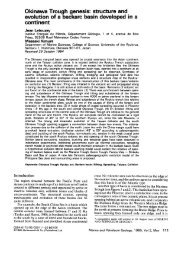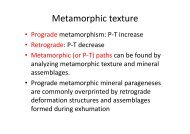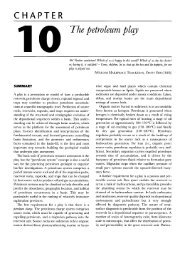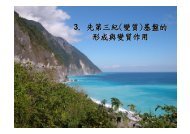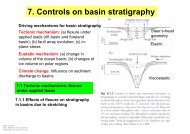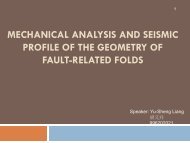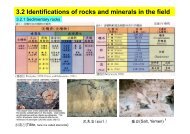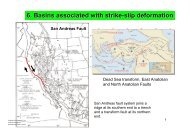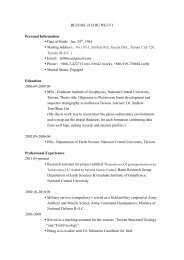44( )M.J. KrausrEarth-Science ReÕiews 47 1999 41–70classification just for paleosols. This system relies onthe presence of stable m<strong>in</strong>erals and morphologicalproperties that tend to be preserved as a soil istransformed to a paleosol. Some of the major soilgroups <strong>in</strong> the Mack classification are identical tothose <strong>in</strong> U.S. classification Ž Table 1 .. Some categories<strong>in</strong> the U.S. scheme were excluded because ofdifficulties <strong>in</strong> recogniz<strong>in</strong>g them <strong>in</strong> the ancient record.For example Aridisols were excluded because thistaxonomic class relies on knowledge of the soilmoisture regime. Several new categories were proposed,some of which have approximate equivalents<strong>in</strong> the U.S. scheme Ž e.g., Protosol .. Others, such asCalcisols, which are dist<strong>in</strong>guished on the basis of acalcic horizon, have no direct equivalent. Gelisolswere added to Soil Taxonomy after development ofthe Mack et al. classification ŽSoil Survey Staff,1998 .. These are soils that have permafrost with<strong>in</strong> aparticular depth or have gelic materials, which arethe result of cryopedogenic processes.The Mack et al. Ž 1993.system has been receivedwith some favor because it is designed for fieldidentification of paleosols and because it makes paleosolclassification more objective and simpler and,thus, achievable to a broader group of geologists.Despite these advantages, the system has flaws,which Retallack Ž 1993.outl<strong>in</strong>ed. One concern isthat, because of its restriction to paleosols, the use ofthis classification will weaken the communicationbetween soil scientists and paleopedologists. A secondconcern is that, because paleopedologists rely onmodern soil analogs to <strong>in</strong>terpret ancient environmentalconditions, the environmental value of paleosolswill be dim<strong>in</strong>ished by a classification that is specificto paleosols.Why classify paleosols? In general, scientificclassifications serve to organize <strong>in</strong>formation and tofoster effective communication about a particularsubject. Classifications also provide guidel<strong>in</strong>es forfuture studies <strong>in</strong> a particular subject by emphasiz<strong>in</strong>gwhat factors or properties are important. With paleosols,we want a classification system or systemsthat accomplish these goals. But, because paleosolsare studied <strong>in</strong> order to help <strong>in</strong>terpret past conditionsand events <strong>in</strong>clud<strong>in</strong>g climates, depositional conditions,and paleoecological changes, Retallack Ž 1993.is right that the classification must be firmly tied tomodern soil systems. The U.S. and FAO classificationsdo have drawbacks for paleosol classification,primarily the fact that these are taxonomic classificationsthat rely on too many features that are commonlyabsent <strong>in</strong> the ancient record. In many ways,the Duchaufour Ž 1982.classification is more easilyapplied to paleosols because of its focus on processrather than modern soil properties. Morphologicaland geochemical properties that are preserved <strong>in</strong> therock record are usually sufficient to determ<strong>in</strong>e thesoil form<strong>in</strong>g processes that occurred and then toclassify the paleosol. Another advantage of theDuchaufour classification is that it recognizes soil<strong>in</strong>tergrades, which are soils that occur between twoclasses. For many paleopedologists, the major deterrentto us<strong>in</strong>g the Duchaufour classification is probablythat many of the soil categories are so dissimilarfrom the commonly used U.S. categories and thenames themselves are so different Ž Table 1 .. Yet, if aresearcher can get beyond the unfamiliar term<strong>in</strong>ology,the process-oriented approach of this systemcan be effective for classify<strong>in</strong>g paleosols.3. <strong>Paleosols</strong> and timeThe k<strong>in</strong>d of paleosol that forms <strong>in</strong> the <strong>sedimentary</strong>record depends on how rapidly the sedimentaccumulated, whether that accumulation was steadyor discont<strong>in</strong>uous, and, if pauses occurred, <strong>their</strong> duration.Sediment accumulation varies through time,produc<strong>in</strong>g different k<strong>in</strong>ds of paleosols upwardthrough a vertical succession Ž Fig. 1 .. Sedimentarypaleosols form a cont<strong>in</strong>uum, at one end of which aremultiple paleosols, which formed <strong>in</strong> relatively thickand conformable stratigraphic successions becauseaggradation was relatively cont<strong>in</strong>uous Ž Fig. 1B .. Butvarious autogenic processes Žthose that are <strong>in</strong>herentto the depositional system.and allogenic processesŽ those that are external to the depositional system.produce episodes of landscape stability or erosion.Depend<strong>in</strong>g on the particular process and the timescaleover which it operated, stratigraphic gaps ofvarious magnitudes Že.g., diastems and unconformities.will develop <strong>in</strong> the stratigraphic succession.Many of these surfaces will be marked by thick andvery strongly developed paleosols, which are theother end member <strong>in</strong> the paleosol cont<strong>in</strong>uum ŽFig.1A .. The follow<strong>in</strong>g sections provide a more detailed
( )M.J. KrausrEarth-Science ReÕiews 47 1999 41–70 45Fig. 1. Schematic diagram show<strong>in</strong>g the range of paleosols that can form <strong>in</strong> a thick vertical section depend<strong>in</strong>g on whether sedimentaccumulation was steady or discont<strong>in</strong>uous, and, if pauses occurred, <strong>their</strong> duration. Ž A.A thick and strongly weathered paleosol formed on anunconformable surface because of a lengthy period of landscape stability and soil development. Ž B.A thick sequence of multiple paleosolsformed on floodpla<strong>in</strong> deposits because erosion was <strong>in</strong>significant and sedimentation was steady. Ž C.A moderately long pause <strong>in</strong>sedimentation related to valley <strong>in</strong>cision produced a paleosol that is more strongly developed than the multiple paleosols but not as <strong>in</strong>tenselyweathered as the paleosol at the unconformity. This paleosol has partly overlapped one of the underly<strong>in</strong>g multiple paleosols.description of paleosols of different temporal magnitudesand the processes by which they form.3.1. <strong>Paleosols</strong> <strong>in</strong> aggradational systems<strong>Paleosols</strong> can be classified accord<strong>in</strong>g to the balancebetween sediment accumulation and the rate ofpedogenesis Že.g., Morrison, 1978; Marriott andWright, 1993; Wright and Marriott, 1996.Ž Fig. 2 .. Iferosion is <strong>in</strong>significant and sedimentation is rapidand unsteady, compound paleosols usually form ŽFig.2A .. These are weakly developed, vertically stackedprofiles that are separated by m<strong>in</strong>imally weatheredsediment. If the rate of pedogenesis exceeds the rateof deposition, vertically successive profiles maypartly overlap, giv<strong>in</strong>g rise to composite paleosols. Incontrast, if erosion is <strong>in</strong>significant and sedimentationis steady, thick cumulative soils can form Ž Fig. 2B ..



